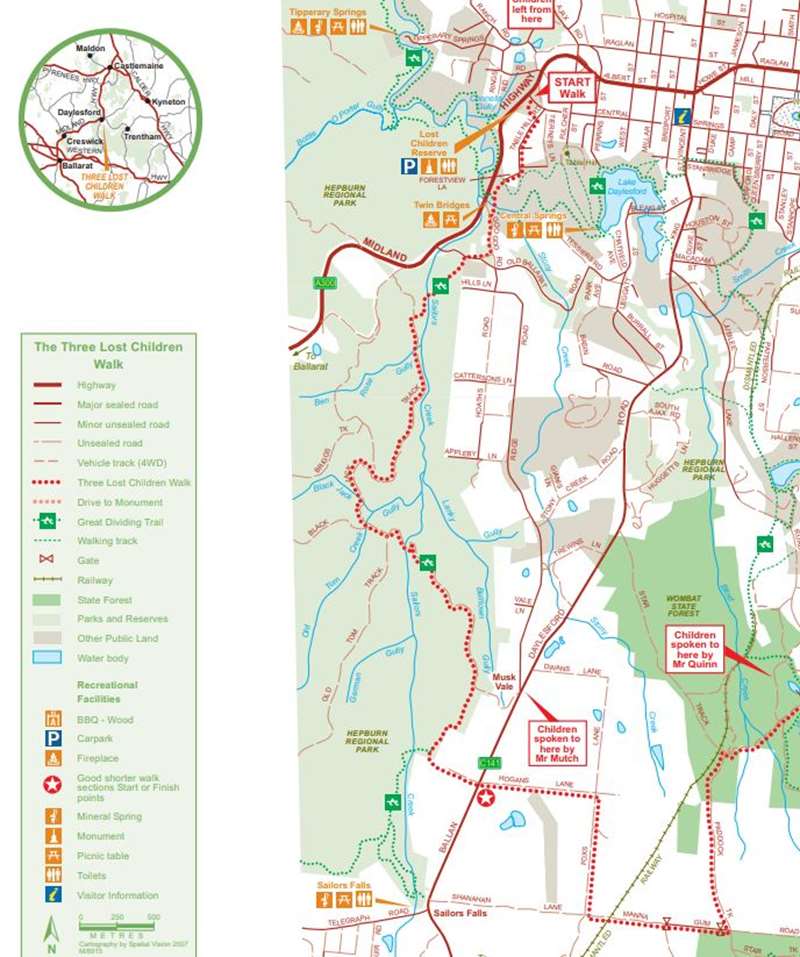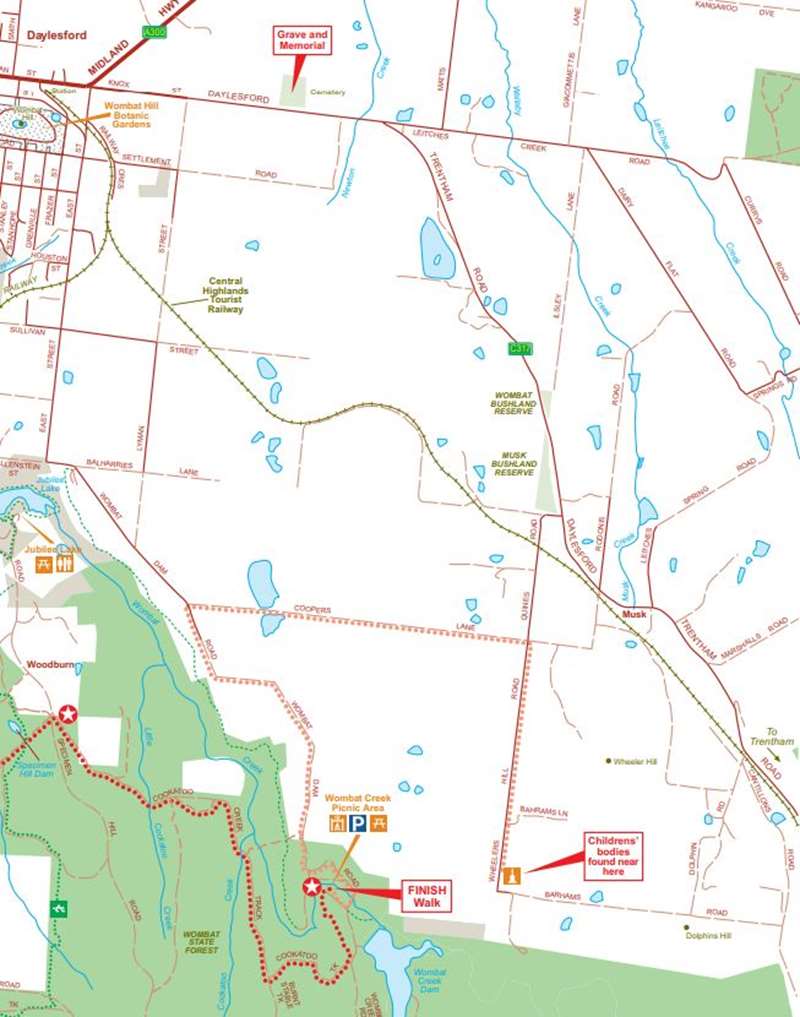Daylesford - Three Lost Children Walk

This walk commemorates the tragic story from Daylesford's gold era when three small boys wandered away from their homes in Daylesford in 1867. Despite a massive and lengthy search effort the boys were not found alive.
The Three Lost Children walk follows the approximate route the boys walked. The walk will take you through bush landscapes that were once active goldfields, and now part of the Wombat State Forest and the Hepburn Regional Park. Along the walk you will see the remnants of gold mines, water races and tramways.
The Three Lost Children Walk Summary:
Grade of Walk: Grade 3
Distance: One-way 15km
Time: 6 hours (including breaks)
Gradient: Gentle hills
Quality of Path: Formed track, some obstacles
Quality of Markings: Sign posted
Steps: Occasional steps
Experience required: Some bushwalking experience recommended
Suggested pick-up or set down points are shown, for those people wishing to walk only part of the track. Follow the "Three Lost Children Walk" markers along the track. The map is accompanied by descriptions of the walk starting at the Lost Children Reserve on the corner of Midland Hwy and Central Springs Rd Daylesford.
The Story
The call of adventure
It was Sunday morning, 30 June 1867, when a group of young children from Connells Gully, near Table Hill, Daylesford, wandered in the direction of Wombat Creek past familiar shallow gold diggings to look for wild goats.
Three children, William Graham, aged 6 and a half, his brother Thomas, 4 years 3 months, and Alfred Burman, 5, responded to the call of adventure. They crossed Wombat Creek and headed towards Muskvale.
When the boys failed to return home for lunch their fathers began to search, concentrating their efforts near the junctions of the Wombat, Stony and Sailors Creeks. That evening the police were notified, and the search went well into the night.
During the afternoon the boys had spoken to a Muskvale storekeeper, Mr Mutch, but failed to follow his instructions on how to reach Daylesford. After a short distance they unaccountably headed east to Specimen Hill.
Towards dusk the children then spoke to an older boy, John Quinn, near Specimen Hill gold mine. He told them they were lost, but they ignored his attempts to turn them back and vanished into thick bush to their impending doom.
Organised searches
At dawn on Monday 1 July, the search began in earnest. As news of the previous day's sightings circulated, the search area widened. Community anxiety grew, and the next day more than 100 horsemen assembled near the Specimen Hill gold mine. By Wednesday 3 July, after a public meeting the previous night called by the Mayor, Cr Bleakley, sympathy for the distressed families was so heightened that almost 700 people turned out in cold, miserable weather to continue searching.
The sorrowful discovery
After eight successive public meetings and 25 days of searching it appeared that the tragedy of the Three Lost Children might never be solved.
But on Friday 13 September a dog returned home to Wheelers Hill, some 10km from Daylesford, carrying in its mouth a small boot with a child's foot in it. The following day a number of Wheelers Hill residents combed the area and found the bodies of the youngest boys in the hollow of a tree. The remains and clothing of the older boy were nearby.
There was a large funeral, and the three children were buried together in the Daylesford Cemetery. An
impressive monument was erected there by public subscription - you can see it today in the cemetery on the Daylesford-Trentham Road.
In 1889, Mr Graham, the father of two of the lost boys, established a scholarship to be presented each year to the best boy and girl pupils at Daylesford State School. In this way the memory of the Lost Children has been kept alive in the Daylesford District.
Three Lost Children Walk Maps


Daylesford: The scene in 1850s and 60s
Gold was discovered in Daylesford in 1851 in the areas known as Wombat Flat and Connells Gully. Tom Connell was credited as being co-discoverer of the first gold. While gold prospecting development was fairly slow with two or three hundred diggers active in 1852, by 1855, diggers numbered in the thousands as new fields opened up at Yandoit, and later Coomoora. The Graham, Burman and Griffiths families lived in the Connells Gully area. William Graham, father of two of the lost children, was a miner who later went on to discover rich buried leads at Allendale.
Many Chinese worked the local fields, and other turned their hands to market gardening. There were Chinese market gardens in the Wombat, Stony Creek and Sailors Creek areas.
Teams of six, eight or ten horses pulled many laden wagons of timber out of the nearby forest for use in the mines, as underground mining and quartz crushing developed in the early 1860s. One such mine was the Specimen Hill mine, which the Children passed on their journey.
Dams were constructed, with water run along water races to sluice gullies and to power the minefields. The remains of one such dam can be seen on the south side of The Lost Children Walk at Blind Creek, with the sluicing works to be seen on the North side of the track. Water races can also be seen along Cockatoo Creek Track.
Sailors Falls Reserve
The Lost Children Walk meets the Great Dividing Trail at Wombat Creek. North of the Lost Children Walk the Great Dividing Trail passes Tipperary Springs then continues through to Bendigo.
The Great Dividing Trail follows The Lost Children Walk south-west through to Hogans Lane. At Hogans Lane an optional 2.5km return extension can be added to the Lost Children Walk to include the picturesque Sailors Falls Reserve. From Hogans Lane the Lost Children Walk heads east to again cross the Great Dividing Trail near Specimen Hill Dam. This is the Lerderderg section of the Great Divide Trail running from Daylesford through to Bacchus Marsh.
Safety on the Walk
- Be Safe - Be Prepared
- Wear sturdy footwear with good tread
- Walking track may be uneven and slippery
- Take clothing for variable weather conditions
- Take sufficient water and food
- Carry a good quality map
- Deep mine shafts are present in the Park and Forest - Keep to the walking tracks, mind your footing and supervise children at all times
Location
Cnr Midland Highway and Central Springs Road, Daylesford 3460 View Map
Web Links
→ Three Lost Children Walk Brochure (PDF)









